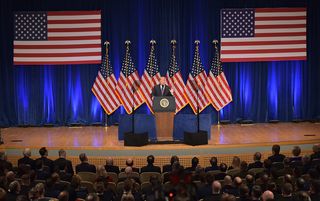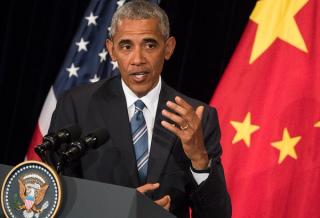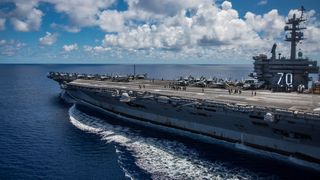Introduction
One year ago, in an insightful analysis for the United States Studies Centre, Ambassador David Shear described a “dual crisis” in American policy toward Asia. Under President Donald Trump, he observed, the United States was beset by a “crisis of distraction” caused by political squabbling at home, an obsession with issues of immigration, taxation and other “hot button” topics, and inadequate staffing of the Department of State and other key institutions. At the same time, Trump’s erratic, often irritating, style and his evident indifference to long-standing security relationships was also causing a “crisis of credibility”, undermining confidence in US security commitments and trust in American reliability.
Regrettably, the succeeding 12 months have done nothing to change this assessment. This reality lies behind my assessment of American military strategy and force posture in the Indo-Pacific region, and raises concerns about the prospects of the United States and its allies as they seek to protect and advance their collective interests in an increasingly demanding security environment.
If American policymakers can make sound decisions about how to evolve the capabilities, operating concepts and posture of their armed forces, and embed these in sensible policies for the region, a balance of power can be sustained.
My analysis concentrates on several related issues: the United States’ enduring policy goals in the region; the factors impinging upon those goals, with a specific focus on the military challenges posed by China; whether the Trump administration has a viable strategy for achieving its goals; and what this might mean for America’s future role in the Indo-Pacific.
While the rise of China poses serious challenges for the United States and its allies, I conclude that these challenges are far from insurmountable. If American policymakers can make sound decisions about how to evolve the capabilities, operating concepts and posture of their armed forces, and embed these in sensible policies for the region, a balance of power can be sustained — one that is capable of preserving the foundation of the rules-based order that has underwritten the region’s peace and prosperity for so long. This is not a question of resources or technology; it is a question of American wisdom and will.
America’s goals in the Indo-Pacific
Simply stated, the United States has three primary goals in the Indo-Pacific: security, peace and prosperity for ourselves and for the region. These are not in any way new. The same statement could have been made 20, 40 or 60 years ago. Indeed, these goals sound anodyne to the point of banality; but they are — or, at least, they should be — real and meaningful guides for US strategy and policy.
Americans learned the hard way after fighting two wars in Asia between 1941 and 1953 that deterring aggression through alliance building and forward engagement is vastly preferable to trying to reverse aggression once deterrence has failed. If our alliances are strong, if we convey our intent and will to defend, and if we maintain an underlying balance of military power, we can expect to deter overt aggression against our common interests. And if peace and stability are assured and we pursue sound trade and macroeconomic policies, growth and prosperity generally follow.

In an interdependent world, no nation can provide for the wellbeing of its people without the ability to influence events and decisions abroad. No major policy goal — be it sustained economic growth, defeating terrorism, protecting the environment or something else — can be achieved unilaterally these days, regardless of how powerful a nation may be. For the United States, other than our immediate neighbours in Canada and Mexico, no region has more potential to affect our quality of life than the Indo-Pacific. So our fate is inextricably tied to this region and we must do what we can to influence events and shape the region’s dynamics.
The challenges posed by a rising China
Nation states develop strategies for pursuing their objectives in the presence of forces in the environment — threats, challenges and opportunities — that may impinge upon those objectives. One can point to a number of developments in the Indo-Pacific that matter to the United States: North Korea’s nuclear and missile program, environmental deterioration, deepening economic integration, technology transfer and innovation, capital flows and more. But the factor with the most potential to disrupt the existing order of things — and the one that arguably touches on all other developments — is, of course, the rise of China.
China’s burgeoning economy has fuelled an activist foreign policy aimed at expanding Beijing’s influence throughout the region and beyond. Under Xi Jinping, China is proving to be more of a revisionist power than many had hoped or expected. This is taking place despite the fact that China has done extremely well for itself by operating largely within the rules of the current international order.
In the military dimension, China in less than 20 years has comprehensively modernised its armed forces in support of a strategy aimed at denying effective military intervention by an outside power and giving Beijing freedom of action around its periphery. The pace and scope of China’s military modernisation effort have been nothing short of remarkable.
Americans familiar with the superior performance of US and allied forces in wars against the armed forces of Iraq, Serbia, Afghanistan and Libya tend to have a sense of complacency about the military balance today and in the future.
Fifteen years ago, it was fashionable in US defence circles to speak of the impending “transformation” of the armed forces. Secretary of Defense Donald Rumsfeld sought to make this the central theme of his tenure. He and others envisaged a future in which US forces enjoyed a nearly comprehensive understanding of the battlespace and, with it, the ability to rapidly and precisely impose desired effects on the enemy. One could debate whether and to what extent US forces have actually transformed since then. While there have been some major improvements in capabilities and techniques, particularly in the conduct of counter-terrorism and stability operations, by and large US forces do not look or operate dramatically differently than they did at the turn of the century.
By contrast, there can be no doubt that China’s military has transformed dramatically over that period. Think of the experience of a Chinese fighter pilot who was a lieutenant in 2000. When he walked out to the flight line, he sat in the cockpit of an aircraft that, by Western standards, had been obsolete for more than 20 years. Its weaponry was of poor quality, as was his training. Once airborne, he was limited to following the orders of a ground controller who told him how to manoeuvre and to conduct an engagement. All of that has changed profoundly. The same fighter pilot, now a lieutenant colonel, climbs proudly into the cockpit of a fighter whose aerodynamic performance, avionics and weapon systems are on a par with frontline Western fourth-generation fighters such as the F-15, F-16 and F-18. And his training, which emphasises “free air combat” and tactical autonomy, is catching up to those of Western air forces as well.1 The same is true for his counterparts in the Chinese navy, air defence forces and rocket forces, not to mention China’s space and cyber forces, which did not even exist 20 years ago.
The main elements of China’s new military portfolio are well-known:
- China today boasts the world’s largest force of modern, conventionally-armed ballistic and cruise missiles. These weapons can be fired from land, sea and airborne platforms, and pose serious threats to US and allied land and sea-bases throughout the Western Pacific.
- China has fielded dense arrays of modern surface-to-air missiles, complemented by an increasingly capable air force. These forces can deny US and allied forces the ability to operate effectively in the air over key parts of the battlespace, such as the Taiwan Strait and portions of the South China Sea, especially in the critical early phases of a conflict.
- China has made rapid strides in fielding a full suite of military-related space systems. Its space forces today include systems for reconnaissance, communications, satellite navigation and meteorology, all of which are essential for the orchestration and conduct of modern, joint military operations.
- At the same time, China’s growing force of anti-satellite, electronic combat and cyber weapons can disrupt or physically destroy many of the systems and facilities that provide US and allied forces with these same capabilities.2
These and other capabilities — combined with the geographical advantages enjoyed by a state fighting close to its own territory — mean that Chinese forces have the potential in a conflict to hold an intervening power at bay for a period of time sufficient to execute offensive operations and impose high costs in terms of human casualties and destroyed equipment.3
Should US allies and partners lose confidence in the ability of American forces to project conventional power into their regions, and to deter intimidation and defeat aggression, an important part of the glue that has held together the coalition keeping the peace and advancing common interests will be lost.
Americans familiar with the superior performance of US and allied forces in wars against the armed forces of Iraq, Serbia, Afghanistan and Libya tend to have a sense of complacency about the military balance today and in the future. But US forces have not been called upon to fight an adversary that could effectively attack forward bases, contest American air superiority or disrupt critical systems for command and control, reconnaissance and positioning, navigation, and timing. They now face two such adversaries — China and Russia; and wargaming and analysis show that US forces today are not well prepared for either of these challenges.
Unless these trends can be reversed, the consequences for US interests and for the stability of the Indo-Pacific and Europe could be stark. Should US allies and partners lose confidence in the ability of American forces to project conventional power into their regions, and to deter intimidation and defeat aggression, an important part of the glue that has held together the coalition keeping the peace and advancing common interests will be lost.
A new National Security Strategy
Recognising the rather daunting list of challenges facing the United States and its Indo-Pacific allies, President Obama in 2011 laid out his administration’s strategy for securing and advancing our interests in the region. The “rebalance”, as that strategy became known, included military, economic and diplomatic dimensions, and sensibly built these on the foundations of our regional alliances.
The Trump administration published its National Security Strategy (NSS) in December 2017. Its main elements are not dramatically different from Obama’s strategy, but there are important differences in tone and emphasis. The new strategy is less reticent about calling out China and Russia as strategic competitors and even adversaries. This is salutary. Trump’s strategy calls for major increases in defence spending to support the accelerated modernisation of US military capabilities, an expansion of the overall size of the force, improvements in readiness levels and strengthened regional postures. It also calls for strengthening US alliances and expanding partnerships with other states.4

This NSS was followed in short order by the administration’s National Defense Strategy (NDS). The NDS, too, focuses on the “reemergence of long-term strategic competition” with China and Russia. It stresses that the US armed forces must prepare to fight in operating environments that are far more challenging and contested than those that they encountered in the post-Cold War period. Accordingly, it emphasises the need for the Department of Defense to accelerate efforts to modernise US forces, posture and operational concepts.5
Is the strategy viable?
It is one thing to articulate a strategy and another to make it work. How effective and how viable have the two administrations’ strategies been? Obama’s rebalance suffered from insufficient resources, principally in its military dimension. When this strategy was being developed, the administration had counted on staying out of Iraq and, by 2014, winding down military operations in Afghanistan. It also assumed implicitly that Russia would remain more of a partner than an adversary and that Europe would remain at peace and a net exporter of security to other regions.
None of those assumptions proved viable. By 2014, US forces and advisors, which had left Iraq two years earlier, were on their way back to prevent ISIS from overrunning the country. Increased violence by the Taliban and other terrorist groups in Afghanistan forced the Obama administration to postpone indefinitely the planned withdrawal of US forces from that country. And Russia’s two attacks on Ukraine in 2014 meant that, for the first time since the late 1980s, the United States and its allies in Europe had to contend with the possibility of an attack on NATO territory. This came as unwelcome news to an alliance that had expanded to include 13 new members in the east, while sharply reducing its capacity for territorial defence.

Interestingly, no one in the administration asked for revisions to the defence plan or budget as these unfavourable events unfolded. The result, in retrospect, was predictable: disappointment with at least the military dimension of the rebalance strategy and a continued erosion of the US-China military balance.
To be sure, there have been some efforts to improve US military capabilities and posture. The Pentagon’s “Third Offset” initiative, announced in late 2014, was intended to address key capability gaps by expanding investments and spurring innovation in technology areas deemed central to future high-end warfare, including artificial intelligence, autonomous weapon systems and human-machine collaborative decision-making.6 But, being investments in R&D projects and not actual weapons programs, these initiatives are not likely to be deployed in the field much before 2030. Moreover, it was never entirely clear how these new capabilities would help solve the multiple operational challenges facing US and allied forces. With respect to American military posture, having access to and rotating forces through Darwin and Tyndal in Australia represents a step forward by enabling operations from areas beyond the reach of China’s most numerous strike systems. But, in the main, our allies are still waiting for evidence of a significant increase in the ability of the United States to project power in the region.
While the 2017 National Security Strategy signalled new investments in military modernisation — with the aim of retaining capabilities that would “overmatch” those of China, Russia and other adversaries — it too has thus far failed to deliver in the Asian theatre.
More resources have been provided: the US defence budget for FY2019 reflects an increase of US$82 billion over the 2017 figure, amounting to an increase of 9.3 per cent in real terms.7 But much of this appears to have been earmarked for investments in manpower, pay, training, maintenance and other readiness accounts, with little remaining for modernising the sorts of capabilities that would be required for the force to successfully project power into the backyards, so to speak, of China and Russia. Perhaps in recognition of this, the Deputy Secretary of Defense has promised that the FY2020 budget will be a “masterpiece” shaped by the priorities of the NDS.8
A budget deficit of this size is obviously untenable, and unless it is undone it is difficult to see how the government will be able to stop the erosion of its military capabilities vis-à-vis China and other adversaries, let alone reverse it.
Even if the Department of Defense is able to identify a set of investments that can provide the capabilities called for by its ambitious strategy, it will still have to secure funding on a sustained basis to develop and procure the requisite systems. It is here that the Trump administration and the Republican congressional caucus have created cause for concern. The paramount priority for Trump and his allies in Congress has been the tax cut they passed in 2017. This legislation is expected to produce annual federal budget deficits in the US$1 trillion range by 2020. A deficit of this size is obviously untenable, and unless it is undone it is difficult to see how the government will be able to stop the erosion of its military capabilities vis-à-vis China and other adversaries, let alone reverse it.9
Of course, there is more to strategy than words in a document and hardware in military units. For the United States especially, there is also the quality of leadership that it provides. Here, President Trump’s erratic statements and actions have done damage to US standing in the world. According to a 2017 poll conducted by the Pew Research Center, globally, only 22 per cent of people expressed confidence in Donald Trump to do the right thing internationally. Shockingly, and by contrast, Vladimir Putin came in at 27 per cent and Xi Jinping at 28 per cent.10 And because Trump seems to lack an appreciation for the importance of allies and international institutions, it is easy to imagine how greater damage could yet be done to our strategically important global relationships.
More worrisome than Trump himself is the phenomenon of what might be called Trumpism — the domestic support that exists for Trump and his approach to politics. Despite a continuous series of revelations about incompetence and even malfeasance in his administration, Trump has retained a favourable rating of around 40 per cent among Americans. President Trump’s modus operandi is to give voice and license to the worst facets of American political culture — xenophobia, selfishness and a tendency to blame others for one’s own problems. One result has been a polarised and angry electorate, and a Congress that is unable to produce bipartisan, compromise solutions to national problems. Needless to say, all of this is antithetical to sound security strategy and planning, as well as to basic governance.
A sustainable Indo-Pacific strategy
What might all of this mean for the future of US strategy in the Indo-Pacific and globally? As a simple defence analyst, I will not venture a prediction about the future course of events in this region or within my own country, but will instead keep to some prescriptive observations: What sort of strategy and approach should we and our allies be trying to implement over the coming years and why?
Here, although it may at first seem strange, I think that we can take a cue from China. There is little doubt how the Chinese see things strategically:
- Over the next 10 years, China is projected to spend approximately US$1 trillion on its Belt and Road initiative.
- Over this period, China will spend another US$2 trillion or so sustaining and continuing to modernise its armed forces.
- Chinese forces are engaging in international deployments and exercises at a pace that for them is unprecedented.
- Chinese loans to governments throughout the Indo-Pacific for economic development projects are often followed by pressure to grant access and basing rights to military forces — especially naval forces.11
- All this is in support of a strategy to gain influence, access and the ability to project power across Eurasia.
China, in short, is investing huge sums in an effort to create for itself what the United States and its allies already have: a network of relationships and power projection hubs that can allow Beijing to influence events and decisions across a vast area and, should push come to shove, to enforce their will on those who oppose them.
Why is China doing this? Because it knows that economic growth and military reach and power go hand in hand. Dynamic, growing powers have always behaved this way. So, if one thinks that the 21st century will be defined at least in part by the outcome of a competition between China and the West, we would be well-served by a strategy that begins with an appreciation for what we already have. Put simply, the United States and its allies and partners should be working hard to preserve, adapt, strengthen and extend their security ties, their ability to work together in the defence of common interests and the posture of military outposts they have built in order to support intelligence, presence and power projection operations.
While the military challenges facing the United States and its allies and partners in the Indo-Pacific are serious and growing, it is important to note that they are not intractable.
In his 2018 speech to the United Nations General Assembly, President Trump argued in favour of coordinated international actions to place sanctions on Iran and Venezuela, to fight terrorism, and to expand trade (on his terms). But these and other items on his agenda require the cooperation of many other countries. The core of that international coalition of like-minded nations are the allies and security partners that the United States has cultivated over the past 70 years. Presidents since Harry Truman have all known this. We must hope that Trump learns this as well.
While the military challenges facing the United States and its allies and partners in the Indo-Pacific are serious and growing, it is important to note that they are not intractable. Wargaming and analysis point to a host of options for improving our capabilities and posture in order to confound aggression by even our most capable foes. A discussion of the specifics would be beyond the scope and intent of this analysis, but a few examples illustrate the point:
- Accelerating procurement of currently available anti-ship and land-attack cruise missile systems would allow US forces to effectively engage key targets, such as surface combatants, amphibious ships and marshalling areas from standoff ranges at the outset of hostilities.
- Currently available radar and missile systems can support highly effective ground-based defences against salvo attacks by subsonic cruise missiles. The Pentagon should be planning to deploy those wherever land-based US forces might operate in wartime.
- Fairly simple passive protection systems, such as portable aircraft shelters, fuel bladders, decoy aircraft and airfield damage repair assets, if coupled with concepts for dispersed and agile basing, can significantly reduce the vulnerability of forward-deployed air forces.
- The weapons used by US air forces to suppress and destroy radar-guided surface-to-air missiles have not kept pace with developments by Chinese and Russian systems. New means for electronic jamming and kinetic attack of these systems are available and should be quickly fielded.
- American forces need more robust and survivable platforms for conducting reconnaissance of enemy forces and activities in contested environments. A range of options is available for such systems in the air, space, maritime and land domains.
- More attention must also be paid to ensuring that military forces and headquarters can communicate essential information in a timely manner, even when under heavy attack by cyber, jamming and kinetic means.12
None of these systems or initiatives rely on exotic or immature technologies. Indeed, many have already been developed and tested but not procured by the Department of Defense in meaningful numbers. Nor is a major buildup of military force structure needed. Roughly, an additional 0.3 per cent of GDP — or about US$55 billion per year — applied to the right kinds of investments and sustained year-by-year would be sufficient to move the needle substantially. And if our allies and partners invest smartly as well, the overall effects can be synergistic.
But doing the right things militarily must be accompanied by sound and consistent policymaking from the top — and too much of what is coming from the top in the United States today is troubling, divisive and even counter-productive. A prominent American journalist, writing recently about China’s rise in the era of Trump, quoted an astute Chinese observer of the geopolitical dynamics of our time, saying: “The United States is not losing leadership to China. You’re giving it up. You’re not even selling it.”13
Conclusion
In some debates about the future of America and the West, you can detect a sense of resignation that geopolitical and economic trends are unavoidably leading to the international marginalisation of Western democracies. Avoiding that fate, for the near- to mid-term at least, is not fundamentally a question of means: We — the United States, Australia, our other allies and partners in this region and globally — have the resources, technical know-how, operational savvy and, in the long run we hope, the societal advantages to preserve our influence globally and, hence, our way of life. It is a question of will and wisdom. Can we see what needs to be done, convey that in a cogent way to our electorates and muster the collective will to do it?
Ultimately, this will come down to a question of governance. The United States has historically been most successful when it has been governed by centrists committed to finding pragmatic solutions to both domestic and foreign policy challenges. Given the political dynamics at play in the United States today, it remains an open question whether and when the nation might return to such a consensus-based and can-do model of governance. Until then, one is reminded of the immortal words of the late Walt Kelly, who for many years wrote the American cartoon strip Pogo: “We have met the enemy and he is us.”






